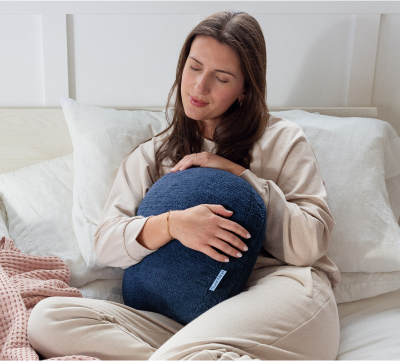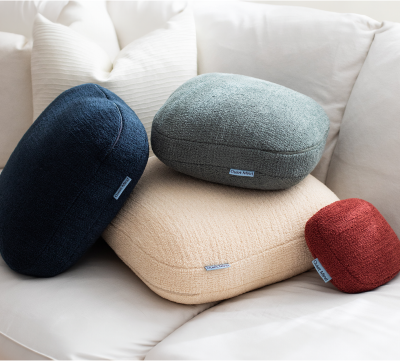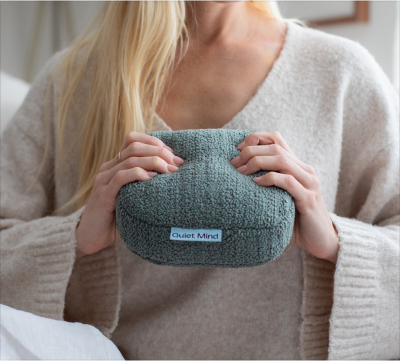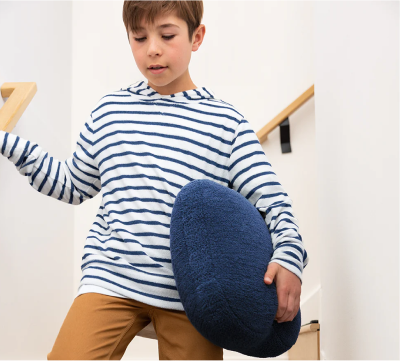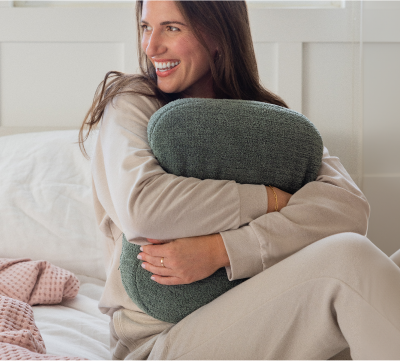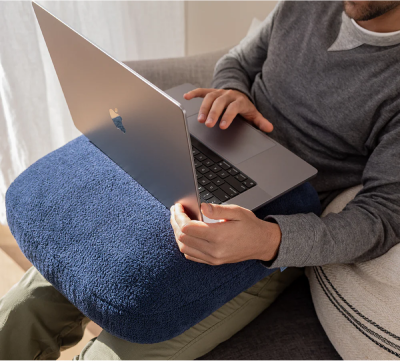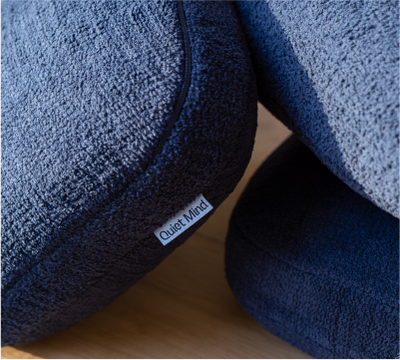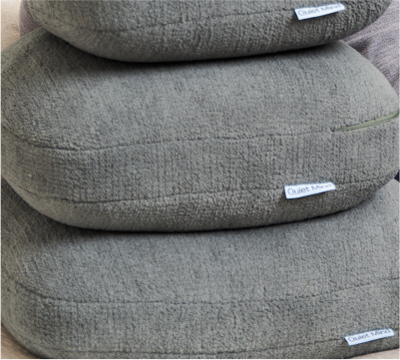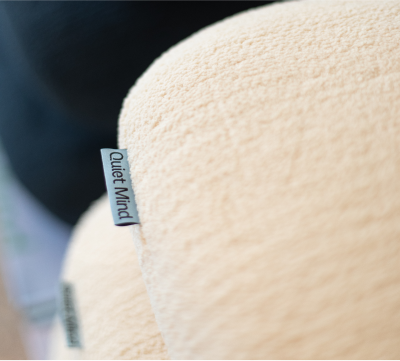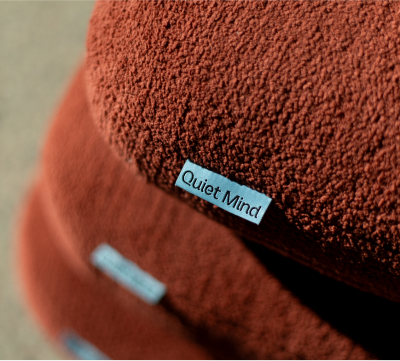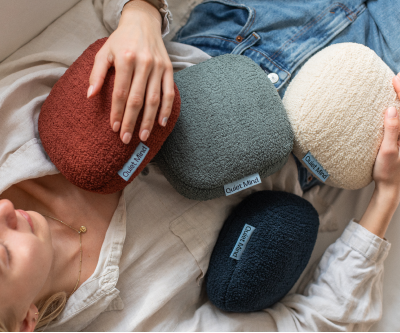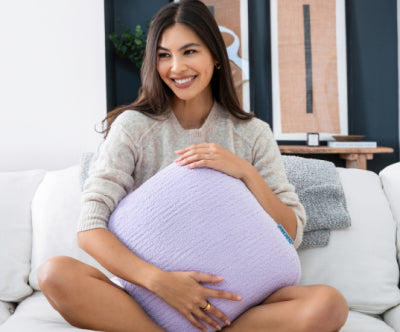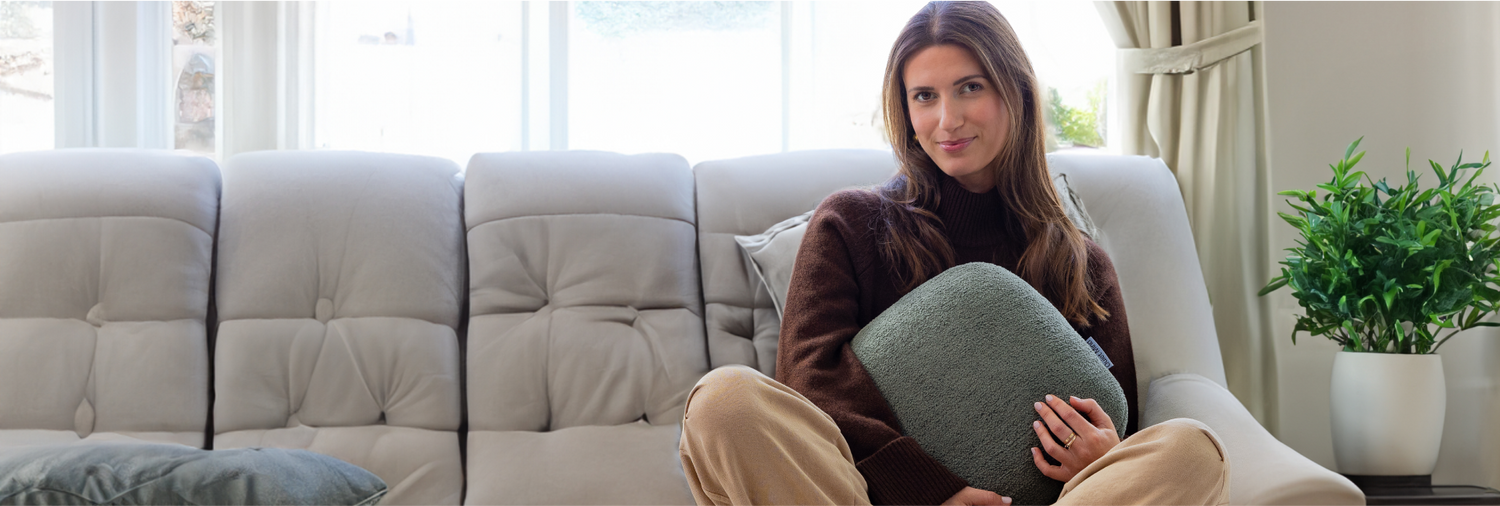Some forms of calm arrive in silence. Others arrive in weight; a gentle pressure, softly anchored, quietly reassuring.
Weighted pillows aren’t just comfort items. They’re practical tools rooted in deep pressure therapy, designed to soothe the nervous system and support emotional balance. But their effectiveness depends on one important detail: the perfect weight.
If a weighted pillow is too light, it may not activate the nervous system enough to provide noticeable relief. If it's too heavy, it may feel restrictive or uncomfortable.
In this guide, we’ll explore how heavy a weighted pillow should be for different body types, uses, and comfort levels, so you can find the right fit to promote restful sleep, reduce stress, and improve your sleep experience.
What Is a Weighted Pillow and How Is It Used?
A weighted pillow is designed to apply gentle, even pressure to specific areas of the body, such as the chest, neck, or lap. Inside, it contains weighted materials like glass beads or microbeads that help deliver the calming effect associated with deep pressure stimulation (DPS).
This sensation tells the body it’s safe, shifting it from the alertness of fight or flight into the stillness of rest and digestion. If you’ve ever wondered whether weighted pillows are good for you, their ability to activate the body’s calming response offers a strong case for their benefits.
Unlike a weighted blanket, which covers the full body and typically weighs 10–30 pounds, a weighted pillow is compact and targeted. It can be used:
- Across the chest to calm the breath.
- Behind the neck to release tension.
- On the lap to support focus and attention during work or meditation.
Because of their size, weighted pillows provide pressure where it’s needed most, offering the benefits of weighted products without the heat or bulk.
Benefits of Weighted Pillows
Weighted pillows offer more than just comfort. Here are some of the key benefits they may provide for emotional, sensory, and sleep support.
|
Benefit |
Description |
|
Anxiety Relief |
Helps reduce stress by lowering cortisol levels and stimulating serotonin |
|
Sleep Support |
Encourages stillness, making it easier to fall asleep and stay asleep |
|
Sensory Regulation |
Useful for individuals with autism or sensory sensitivity |
|
Emotional Grounding |
Provides containment during emotional overwhelm or transitions |
|
Focus and Attention |
Calming lap pressure can improve concentration during tasks |
To unlock these benefits fully, it’s important to choose the right weight for your needs.
Why Weight Matters in a Weighted Pillow
The weight of a pillow is more than just a feature, it’s what makes it effective. Deep pressure therapy relies on pressure that’s firm but comfortable. Too little, and the body doesn’t respond. Too much, and it may cause tension rather than ease.
Deep Pressure Stimulation and Nervous System Response
DPS activates the parasympathetic nervous system, which is responsible for helping the body relax. It reduces cortisol levels (the stress hormone) and increases calming neurotransmitters like serotonin and dopamine. These hormonal shifts can support better mood regulation, restful sleep, and a deeper calming effect.
This makes weighted pillows especially helpful for:
- Adults with sleep disorders or insomnia.
- Individuals with autism or ADHD.
- Anyone seeking to manage daily stress and anxiety.
How Weight Affects Comfort and Safety
For a weighted pillow or blanket to truly feel therapeutic, the weight must strike a delicate balance between gentle pressure and personal comfort. The right weight doesn’t overwhelm. It grounds you. It creates a sensation that’s firm enough to activate the calming parts of the nervous system, yet soft enough to feel safe and breathable.
The perfect weight should:
- Feel grounding, not smothering: When the pressure mimics the secure feeling of being gently held, it can help soothe an overstimulated nervous system. Too much weight, however, may cause discomfort or restlessness.
- Enhance relaxation without interfering with breath or movement: Deep pressure should never feel restrictive. Instead, it should invite stillness, slow breathing, and a sense of ease, especially during sleep or rest.
- Stay centered on the body without pulling or shifting: Even distribution of weight matters. A well-designed weighted pillow stays in place, keeping the calming input consistent throughout use.
- Apply just enough pressure to simulate a hug: This "hug effect" is more than a metaphor. Research has shown that deep touch pressure can activate the parasympathetic nervous system, supporting emotional regulation and stress relief in both children and adults.
Many people seeking sensory support, such as those with ADHD, anxiety, or sleep disturbances, find that the right weight brings a subtle but powerful sense of containment. It’s not about heaviness for the sake of it. It’s about creating the feeling of being gently anchored, helping the body and mind downshift into a calmer state.
What is the Ideal Weight Range for Weighted Pillows?
Unlike a weighted blanket, which typically follows a general rule of using 10% of your body weight, a weighted pillow delivers its benefits through focused pressure on smaller areas of the body. This means you need far less weight to achieve a similar calming effect.
Because weighted pillows target specific zones like your chest, neck, or lap, even a few pounds of evenly distributed weight can help trigger the body’s rest and digest response. That makes them an effective, compact alternative for those who want grounding support without the full-body sensation of a blanket.
Suggested Weighted Pillow Range for Adults
Here’s a general guide to help you choose the right weighted pillow based on your body size and comfort needs:
|
Size |
Pillow Weight |
Recommended Body Weight |
Why It Works |
|
S |
6 lbs |
40–140 lbs |
Light enough for comfort while still engaging the nervous system |
|
M |
9 lbs |
140–180 lbs |
Balanced for anxiety relief, restful sleep, and daily support |
|
L |
12 lbs |
180+ lbs |
Provides deeper pressure for grounding without feeling overwhelming |
Prioritize Comfort and Awareness
Let personal preference guide you. If you’re new to weighted products or sensitive to touch or heat, it’s best to start light. On the other hand, if you're already using a weighted blanket or have a higher body weight, a slightly heavier pillow may feel more grounding and familiar.
The goal isn’t to hit an exact number, it’s to find the perfect weight that makes your body relax and your mind settle without tension or restriction.
Lightweight vs. Heavier Pillows: What to Consider
Choosing the right weighted pillow involves more than matching it to your size. You’ll also want to think about how and where you’ll use it, what your sensitivity levels are, and how quickly your body adapts to deep pressure stimulation.
Lighter Weighted Pillows (2–4 lbs)
- Easier to shift or reposition.
- Great for travel, office desks, and short-term rest.
- Suitable for people with heightened tactile sensitivity.
- Ideal for teens, smaller adults, or anyone sensitive to weight or temperature.
Heavier Weighted Pillows (5–7 lbs)
- Provides a deeper calming effect.
- Best for bedtime, long rest periods, or emotional grounding.
- Often preferred by individuals who already use a weighted blanket size of 15+ lbs.
- May feel too intense for those new to deep pressure therapy.
No matter the weight, your pillow should feel soothing, not smothering. Pay attention to your breath and posture. If the pillow causes discomfort or restlessness, it's likely too heavy. If it feels like nothing, it may be too light to be therapeutic.
How to Choose the Right Weighted Pillow?
To choose the right pillow, start by asking: What do I want this pillow to help with?
Different goals; better sleep, anxiety relief, improved focus and attention, or travel comfort. These all call for different weights and pillow shapes. Understanding how to use a weighted pillow for your specific need can help guide your selection and ensure the best results. Here’s how to match your use case to the right specs:
Weighted Pillow Guide by Use Case
This table outlines common wellness goals and the pillow weights that may support them effectively:
|
Use Case |
Recommended Weight |
Notes |
|
Anxiety Relief |
4–6 lbs |
Use across the chest or torso to simulate a grounding hug |
|
Sleep Support |
4–5 lbs |
Helps calm the nervous system to support better rest |
|
Desk/Study Focus |
3–4 lbs |
Lap placement may improve focus and attention |
|
Travel |
2–3 lbs |
Compact and portable, suitable for neck or shoulder use |
Weighted Pillow Guide by Placement Area
You can also think about which part of the body needs support. This table breaks down suggested weights by placement:
|
Placement Area |
Recommended Weight |
Notes |
|
Lap |
3–4 lbs |
Useful during seated tasks for sensory grounding |
|
Chest/Torso |
4–6 lbs |
Offers firm, calming pressure to regulate the nervous system |
|
Neck/Shoulders |
2–3 lbs |
Gentle support for rest, travel, or short naps |
Look for options with machine washable covers to make cleaning simple, especially if you plan to use your pillow regularly or in multiple settings.
Some people find it helpful to own two pillows: a lighter, portable one for work or travel and a heavier one for home use or nighttime routines.
Weighted Pillow vs. Weighted Blanket: Is the Weight Ratio Different?
Though they share a therapeutic principle, weighted pillows, and blankets function differently and require different weight-to-body ratios.
Function and Target Area Comparison
This comparison helps highlight how weighted pillows and blankets differ in function, coverage, and the amount of pressure they provide.
|
Product |
Target Area |
Typical Weight Range |
|
Weighted Pillow |
Head, neck, torso |
3–7 pounds |
|
Weighted Blanket |
Full body |
10–30 pounds |
A pillow requires less weight because the pressure is more localized. The effects are concentrated, not distributed so a lighter weight often goes further.
Why Pillows Require Less Weight for Similar Effects
The head and chest are especially responsive to touch. A few pounds, properly placed, can activate the same parasympathetic response as a much heavier blanket.
This is why even a 4-pound Quiet Mind weighted pillow can offer profound grounding without overwhelming the body.
Safety Considerations for Weighted Pillow Use
Weighted pillows are gentle tools but like anything that interacts with your body, thoughtful use matters.
Precautions for Specific Individuals
While weighted pillows can offer a soothing, grounding experience for many people, they may not be suitable for everyone. Certain health conditions or sensitivities can affect how the body responds to added pressure.
If any of the following apply to you or your child, it’s important to consult a healthcare provider before introducing a weighted product into your routine:
-
Respiratory Conditions
Individuals with asthma, sleep apnea, or other breathing difficulties should use caution with any item that applies weight to the chest, shoulders, or upper body. Even light pressure can sometimes affect chest expansion or respiratory ease, especially during sleep.
-
Circulatory Issues
Conditions that impact blood flow; such as diabetes, peripheral artery disease, or clotting disorders may increase sensitivity to pressure or temperature. Weighted tools should never impede circulation or create a sensation of numbness or tingling.
-
Chronic Pain or Musculoskeletal Sensitivities
People with fibromyalgia, arthritis, joint pain, or spinal conditions may have heightened sensitivity to touch or added weight. While some find deep pressure soothing, others may experience discomfort if the weight is not properly adjusted or positioned.
-
Sensory Processing Challenges (Especially in Children)
Children or adults with sensory processing disorders, autism, or tactile defensiveness may react strongly to unexpected or uneven pressure. For some, a weighted pillow may feel calming and organizing. For others, it may increase distress unless introduced gently and with individual preferences in mind. Also children under three should never use weighted pillows without medical guidance.
Always start with a lower weight and observe how your body (or your child’s) responds. Discontinue use if there is any sign of discomfort, increased anxiety, or disrupted sleep. Weighted tools should feel like a comfort, not a burden.
Safe Usage and Storage Practices
Weighted pillows are designed to offer comfort, not risk. To ensure a safe and soothing experience, it's important to follow a few simple guidelines for daily use, cleaning, and storage. These practices not only protect your health but also help extend the life of your pillow.
-
Always follow product instructions: Each weighted pillow is designed with specific weight limits, materials, and usage recommendations. Review the manufacturer’s guidelines carefully, especially if the pillow is intended for children or individuals with health considerations. Using the product as intended helps avoid misuse and ensures consistent therapeutic benefit.
-
Store in a dry, cool environment: Weighted pillows often contain materials like glass beads or microfill that may be sensitive to heat or moisture. To prevent mold, mildew, or material breakdown, keep the pillow in a clean, dry area; ideally away from direct sunlight, damp rooms, or heating vents.
-
Avoid placing the pillow over the face or restricting airflow during rest: Weighted products should never be used on the face, neck, or in a way that could block breathing pathways. This is especially important during sleep, for children, or anyone with limited mobility. A weighted pillow is meant to calm and not to cover or confine.
-
Check regularly for wear or seam integrity: Over time, fabric seams can loosen or tear, especially with frequent use. Gently inspect your pillow for any signs of damage, leaks, or weakened stitching. If you notice any bead leakage or uneven weight distribution, stop use and consult the manufacturer for repair or replacement guidance.
So, are weighted pillows good? When chosen mindfully, they can become one of the most versatile calming tools in your daily routine.
Common Mistakes to Avoid while Choosing a Weighted Pillow
The right pillow feels intuitive. But common mistakes can interfere with the benefits.
|
Mistake |
Impact |
Recommendation |
|
Choosing too much weight |
Discomfort, restlessness |
Start light; increase gradually if needed |
|
Ignoring sensitivity or size |
Overstimulation or ineffectiveness |
Match pillow to your unique nervous system needs |
|
Not considering the purpose |
Misalignment with intended use |
Choose by intention; sleep, anxiety, travel, etc. |
|
Overlooking material and shape |
Discomfort or overheating |
Opt for breathable, skin-friendly, ergonomic design |
Your body already knows what it needs. The pillow should simply support that knowing.
Final Thoughts: Finding the Best Weight for Your Weighted Pillow
The most effective weighted pillow is not defined by numbers; it’s defined by how it makes you feel. When chosen with care, the right weight brings a gentle calming effect, allowing your body to soften and your mind to slow down.
It may help you fall asleep faster, ease anxious tension, or simply create a pocket of stillness on a busy day. Whether you're using it to support focus and attention at work or for grounding before bed, it should feel like a natural extension of your care routine; not a challenge to your comfort.
There’s no pressure to get it perfect. Start with a weight that feels safe. Let your experience evolve. Over time, this small, weighted tool may become one of your most reliable supports for restful sleep, emotional steadiness, and better sleep rhythms overall. Trust your body. Adjust as needed. And remember, rest isn’t a performance, it’s a practice.
About Quiet Mind
At Quiet Mind, we believe rest is a right, not a reward. Our mission is to support nervous system health through sensory-informed tools and compassionate guidance. Designed for both adults and children, our signature weighted pillows provide gentle deep pressure therapy to help ease stress, support sleep disorders, and promote grounded well-being for neurodivergent and highly sensitive individuals.
We honor the quiet strength of small rituals, like laying down with a weighted pillow or taking a mindful pause. Every product we create reflects our core belief: that healing begins with feeling safe, seen, and supported.
We’re here to help you create a softer space to land, where rest is real, and comfort is always close.
Frequently Asked Questions
What is the recommended weight for a weighted pillow?
Weighted pillows typically range from 3 to 7 pounds, depending on your body size, sensitivity, and how you intend to use them.
How do I choose the right weight for my weighted pillow?
Start light, especially if you’re new to deep pressure. Consider your frame, your preferred sleep position, and how you want to feel while using it.
Can I use a weighted pillow if I have a medical condition?
Always consult a healthcare provider if you have respiratory, circulatory, or chronic pain conditions before using any weighted item.
Are weighted pillows safe for children?
They can be, but supervision and medical input are essential. Children under 3 should not use weighted pillows. For older children, choose lighter weights designed specifically for them.
How do I care for my weighted pillow?
Use a washable cover to protect it. Spot clean or follow specific care instructions. Keep dry and store away from extreme temperatures.
Can I use a weighted pillow for travel or desk use?
Yes. Compact and calming, weighted pillows are ideal for on-the-go regulation; on flights, at your desk, or during breaks.
What is the difference between a weighted pillow and a weighted blanket?
Pillows deliver focused pressure to specific areas, requiring less weight. Blankets distribute weight across the entire body. Each supports relaxation in its own way.
